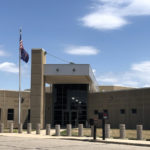During the County Commissioners meeting on Monday, representatives from Tenaska, the company that plans to put a Utility Scale Battery Energy Storage System in Burr Oak had 3 minutes to speak during the public hearing on a moratorium. The Tenaska representatives met with local media at the GIANT fm WTCA studios to discuss the project that afternoon.
James Hingston, Project Development Consultant said they have a portfolio of battery projects in the Midwest, and Jarrod Pitts, Senior Director, Project Development is overseeing those, but he is overseeing the Burr Oak project called Oriole.
The first clarification they wanted to make was that this is a standalone battery storage project with plans to connect to the electrical grid through the Burr Oak substation which is nearly adjacent to the property they have secured a lease option for. The battery project is not connected to any solar project.
This project will connect through a transmission line to the substation and power will flow both ways. The batteries can be charged up when the power demand is low and discharged when the power demand is needed.
The goal of this project is to have a long-term contract with a single utility or a mix of utilities and directly purchase the capacity that the batteries hold. This is a 200-megawatt project that sits on approximately 20 acres. Tenaska has proposed to use Lithium Iron Phosphate (LFP) batteries for this project in Burr Oak which will be their first in the state. James said, “These batteries are less energy-dense so if an overhearing event happens there is less energy there to be released via heat. They are safer and the chemistry is more stable, so it is less likely to run into any issue like that.”
A new Indiana State Law, which is almost solely based on safety is in place and provides a list of requirements such as a meeting with local fire departments and officials to educate them on the project and assist with the creation of Emergency Response Plans that are tailored specifically for this site. Training will be offered before they are installed and operating, and annual training will also be offered. There is not any specialized equipment needed to battle a fire at the facility. The new Indiana law is the strictest law for battery storage in the country.
James said NFPA (National Fire Protection Association) 855 works on-site design to prevent anything from happening and make issues much less severe.
Peter Gray, Vice President of Client Services with Aileron Communications said, “There are at least 20,000 of these kind of battery storage enclosures operating across the country now and new ones getting installed every day. The success rate is well over 99% of these things being safe and operating well.”
James explained the design by saying there are battery cells that are clustered in modules and arranged in racks and placed in an enclosure that looks like a storage container, but it’s built just for this purpose specifically, so it’s not a repurposed storage container.
Jarrod was asked how many enclosures the Burr Oak site would have and he said, “The rough rule of thumb is 1 enclosure per megawatt of power. This project is a 200-megawatt, so 200 enclosures but it could be plus or minus based on design.” It was estimated that the enclosures would take up about 8 to 12 acres of the proposed site.
The project would have 2 full-time employees doing daily routine maintenance and operational work and the site would have 24/7 remote monitoring. The monitoring can see every cell to see how it is operating, and if it goes out of the range for temperature or voltage it automatically shuts off.
Decommissioning was also discussed, and Tenaska rep Jarrod Pitts said they are committed to restoring the land to its pre-project conditions at the end of the project’s useful life. They expect that to be part of the county’s zoning ordinance.
James explained that the battery cells are sealed, placed inside a module that is also sealed, and in the enclosure creating a lot of layers and the materials of the batteries won’t contact the ground, even in a malfunction. The enclosures sit on a concrete pad and the batteries are not liquid like an automobile battery, they are mostly solid.
The value of this project was another key point. They estimate this project to be a $300 million investment with over $20 million in property tax revenue over the life of the project. They said $11 million would go to the schools. The project isn’t a drain on local services because it won’t bring new families that need schools. They won’t be using public utilities and there will be no increased traffic during the operation of the project. The project brings a lot of revenue and not a lot of strain to the county.
Tenaska typically trucks in the materials to construct the project. They would work with the county on a road use agreement including a survey of the roads before and after. They are committed to putting the road back to its prior condition or in better condition.
When asked what the attraction in Marshall County was for this energy battery storage project they said the attention from utilities that want a project in this area and the site selected is extremely close to an existing substation that has open positions for projects to plug into it along with buildable land.
When asked about their timeline James said they are in the 2-year pre-development stage. They are working on the site design and working on the back-in with the grid operator and logistics. If everything goes well construction would begin in late 2024 or early 2025 and it takes 12 to 18 months and operational in 2026 or early 2027.
Tenaska will be talking with the public about the Burr Oak project as it begins to develop. It will be dependent on the county’s zoning ordinance on battery storage facilities so until all the parameters are in place, they can’t create a definite site plan until they have all the particulars.
The Tenaska website has general information on their battery storage projects at www.tenaska.com.












